Every culture has it’s own particular rituals of wedding – some funny, some mesmerizing – all interesting. A hindu wedding is one of the most elaborate ones in the world. There are several stages and rituals that mark it. Colorful costumes, beautiful decorations, delicious food, big gathering of relatives and lots of music go hand in hand at a typical hindu wedding. And the rituals spread over several days. Earlier the whole extended family used to gather at the wedding destination days in advance. And from then onwards, everyday there used to be some rituals, some celebrations.
After the fast modernization of society, that tradition is almost over. Now, mostly things get over winthin a day. All the rituals are performed on that single day in lieu of time. Nevertheless, the major rituals and customs of a traditional Hindu wedding are still followed. As was evident when we saw the depiction of the wedding in Bagore ki Haveli Museum. Although, there is lots of show off now a days, still there is a beauty and delicacy attached to each of these important rituals of the wedding. And there is a certain significance of each one of these.
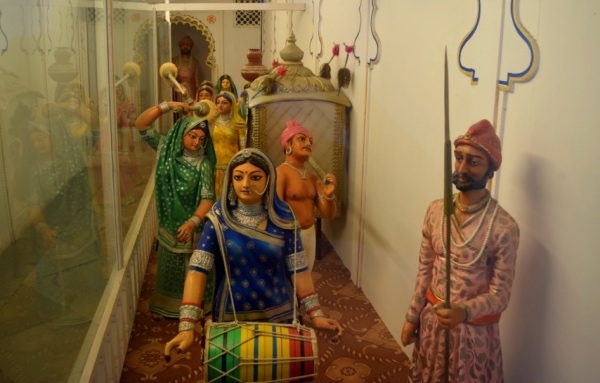
Recently, we had a visit to Bagore Ki Haveli Museum in Udaipur, Rajasthan. While going through the rooms of this Haveli, we saw different sections of the museum dedicated to weaponry, puppets, musical instruments and turbans. Then, we were about to exit. That is when we saw something tugged away in a section of the Haveli. It is marked something like “stages of a royal hindu wedding”. A museum with a section dedicated to wedding on display !! Curious , we immediately headed here.
What we saw inside, was a very pretty section depicting the stages of a royal hindu wedding through colorful 3-D models. It was not just the sheer beauty of the depiction that attracted us. But, we were also amazed on how old the rituals go back in history and they still continue to be integral part of a hindu weddings (yes, we performed those rituals at our wedding too). We have got to dedicate a post to this beautiful depiction of the wedding. So, let us take you through this beautiful journey of a wedding, as seen at Bagore ki Haveli.
Table of Contents
The Sangeet
Music is an integral part of celebration. Not only is it considered auspicious, but also believed to fill our heart with joy. That’s the reason, it is an important ritual of the wedding. There is a function called sangeet that is performed at the bride’s place. Ladies sing and dance in joy of the celebration during this function.
Although apart from the sangeet ceremony, almost all other rituals will have music going on in the background. Particularly on the day of the wedding, the music doesn’t stop at all. That is what is rightly depicted through the models of these three musicians, sitting with their musical instruments. Mostly, these musicians will be sitting near the entrance to the wedding hall, playing some soothing beautiful tunes, as a welcome to the guests. Even in today’s era of musical bands, pen drives and CDs, nothing is still able to beat the sound of this live music!!
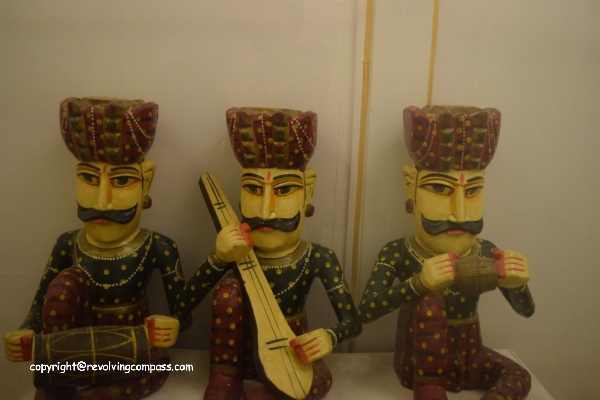
The Mehendi
First of all comes the ritual of Sangeet. Sangeet is often followed by mehendi ritual. Mehendi or Heena is an art made on the hands with extract of hina leaves. It then leaves color on the hand as per the pattern formed. Beautiful patterns are made at the bride’s hand using the mehendi, before the wedding day. Mehendi is considered one of the major Sringar (makeup) items into the hindu culture. And there is a scientific reason behind it. Mehendi leaves have a cooling and soothing effect. When applied at the palm and legs, the essence of the leaves gets soaked into the skin. Thereafter, leading to a cooling and soothing effect. Often our hands work a lot during the functions. Application of mehendi is a way to not only rest them, but also to bring their temperature down.
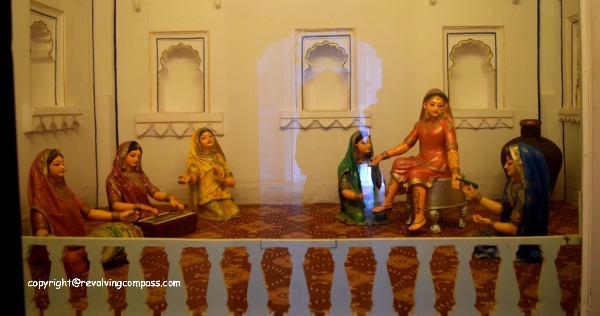
The Wedding day
The ‘big day’ itself sees several significant rituals. They start in the evening, with the Baraat and continue whole night, mostly through whole of north India. In some parts of South India, similar kind of rituals are performed, but during the day.
Baraat
Baraat is the groom’s wedding procession to the wedding avenue. At the time of royal weddings, the groom would proceed for the wedding on a mere to the bride’s palace. The procession would include family members, royal employees and music players. They are welcomed at the bride’s place upon arrival. The baraat also comprises of musicians who will be playing music while the procession goes on. Also, in ancient times when there was no light on the streets, the baraat would have some people carring light arrangements along the procession to lighten up the path. Some youngerters who are enthusiastic enough, go with the flow and even dance through the procession. When such a procession comes out on the roads, particularly a royal one, people from all the houses on the way will rush to their windows and balconies to get a glimpse of the procession. Overall, as and when the procession passes through a street, it lightens up the street with its energy level.
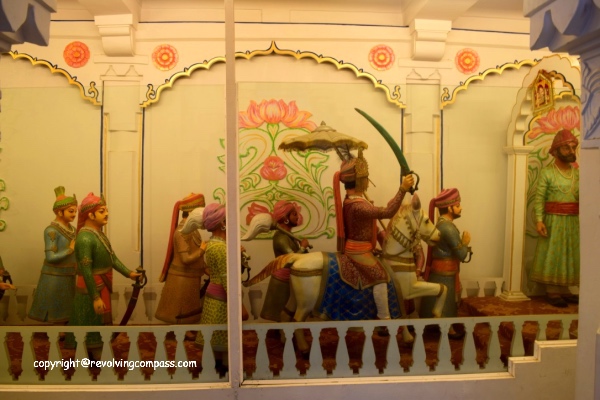
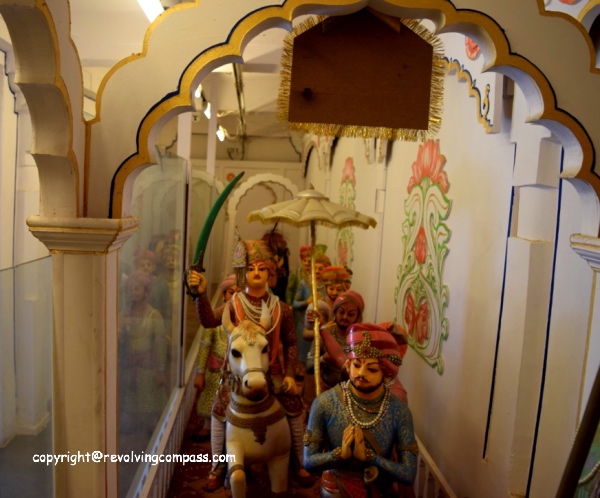
Aarti
Once the groom arrives at the bride’s place, he is welcomed by the bride’s mother and her relatives. The would-be-mother-in-law welcomes the groom with a thali (plate) with a diya (a small cup-shaped oil lamp made of baked clay) in it and takes his Aarti. She also puts a Tilak on his forehead. Post this, the groom proceeds to the wedding.
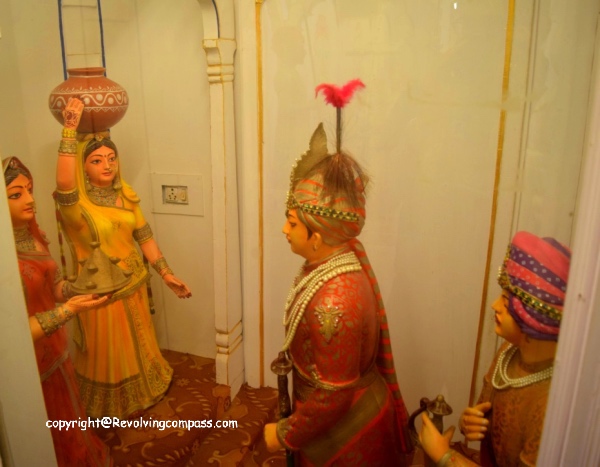
Fere
Once the wedding ceremony starts, there are several rituals performed. One of the most important ones is “phere” wherein the bride and groom take seven circles around an auspicious fire. These circles are called fere. Each circle has it’s own significance. These significant facts are listed in the hindu mythology.
The first circle signifies food. So, in this phere, the couple prays to God to give them enough strength so that they can walk together through their life and manage the food for themselves and their family.
In the second circle the couple prays to God for a healthy and prosperous life. This beings in terms of both mental and physical fitness.
Then follows the third circle, wherein the couple prays to God to give them strength and show them the path to earn wealth and bring prosperity to their lives, working together. Also, they take an oath to stand together in good as well as rainy days.
Thereafter comes the fourth circle. Herein the couple promises to respect each other as well as their families.
In the fifth circle, the couple wish to have beautiful and noble children.
In the sixth circle, the couple prays and wishes for bountiul seasons all over the world. They assert their wish to travel together through these seasons during their long life together.
Then follows the final seventh circle and the final vow. This one signifies everything else that is important for a couple’s happy life. Here, the couple together wish and vow to maintain understanding, companionship, care and loyality towards each other for the rest of their lives.
Thus completes the 7 significant vows around the fire. While the couple take these vows, the rest of the family members stand around and shower them with ample blessings. The priest keeps chanting auspicious mantras through the ceremony.
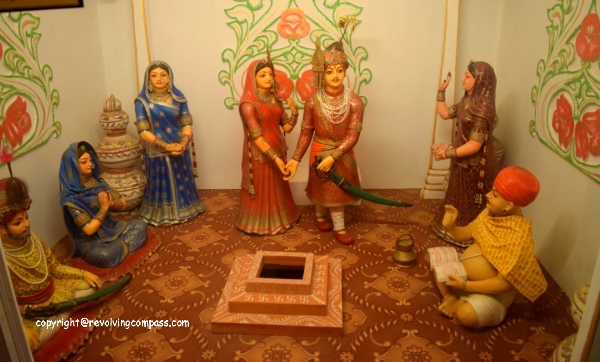
Kunwar Kalewa
The rituals of wedding go through the night. The next morning, groom, along with his younger brother is invited for breakfast at the bride’s house. Here, the family members and relatives of the bride offer sweets to the groom one by one. Simultaneously, they are introduced to the groom. This ceremony marks the introduction and acceptance of newly found relations for the groom. While he enjoys a nice breakfast, he gets introduced to the bride’s family members. (Perhaps with the belief that an introduction over sweets leads to sweet bonding!).
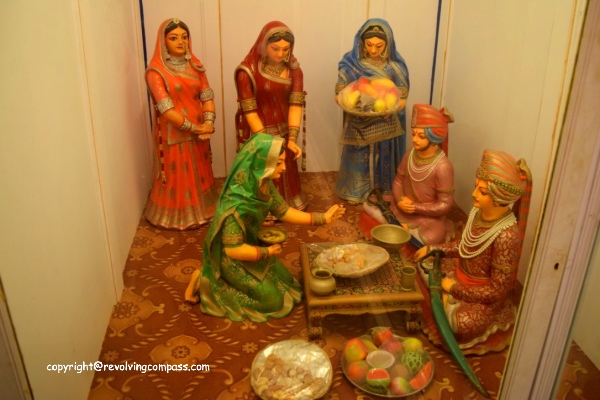
Bidai
The next day, the bride is supposed to leave her home, and proceed to the groom’s place, along with the baraat. While, the groom proceeds on mere, the bride follows in a doli. As a part of royal wedding, several maids and friends of the bride (princess) would also go to the groom’s place with her, to give her company. Bidai is one of the most emotional moment in the life of a bride. Because, the realization of leaving her own birthplace, proceeding to a new home, with newly formed relations strongly overwhelms in the moments of Bidai. Almost everyone at the bride’s side of the family have tears welled up in their eyes during this ceremony.
However, it’s temporary. Soon after, the bride proceeds to the groom’s house and she is welcomed there by the new family members she formed overnight.
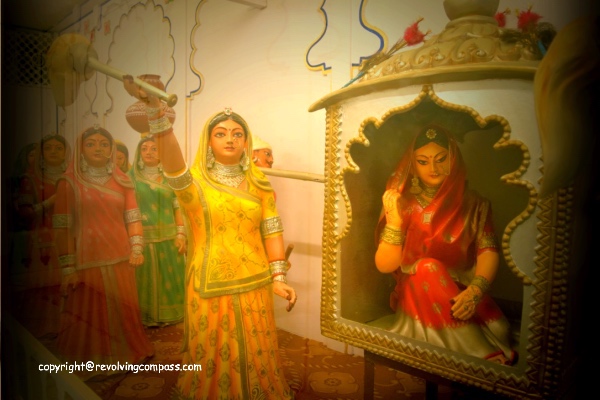
Post wedding rituals
Although, the wedding gets over with the Bidai, but that’s when the post wedding rituals follow. Once the bride arrives at the groom’s place, several rituals are lined up to welcome the couple. In addition, it is important to make the bride feel at ease and comfortable in her new surroundings. At the same time, she has to slowly get introduced to several new relations formed overnight. So, to make things easy and enjoyable, there are some games played at the groom’s place, centered around the bride and groom. Other family members also get actively involved in the games. Through these games, the bride gets slowly introduced to the groom’s side of the family. Also, she starts developing a new bond with the family members of the groom and starts feeling at ease in the new environment.
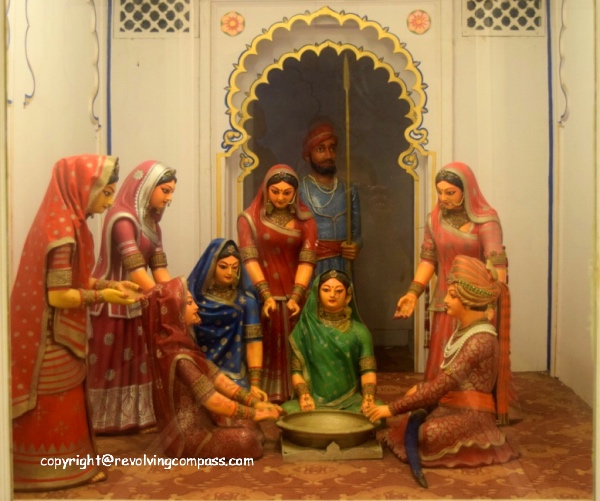
A popular game involves finding a coin in water. (Depicted in the image above). A vessel is filled with colored water. Then a coin is dropped in water. Following this, the bride and the groom are both supposed to search for the coin. At the end, the one who is able to locate the coin first is declared winner. (Before I visited this museum display, I had no idea this game was such an old one. I always thought, it was recently added for fun). This is followed by several other rituals at the groom’s place, spread over a few days. As these rituals are performed, slowly the bride settles into her new life with the groom and his family.
In conclusion, this is how, a couple begins a new journey in their life…together. Couldn’t have been more beautifully depicted.
You might as well be interested in
Shilpgram: Must visit in Udaipur
A day trip to Chittorgarh fort from Udaipur
A day trip to Kumbhalgarh fort from Udaipur
The magnificent Jain Temple of Ranakpur
How best to spend 4 days in Udaipur – itinerary
An evening at Chokhi Dhani, Jaipur
The unconquored fort of Nahargarh, Jaipur
One day trip to Amer fort, Jaipur
Hotel Ram Pratap Palace, Udaipur
Bagore ki Haveli Museum, Udaipur
PS: Some of our links are affiliated, this means we will earn a commission when you buy a service or product by clicking those links. However, this will have no extra cost for you.
Neha, thanks so much for sharing g the world of a traditional Indian wedding with us. So much tradition to absorb!
Thanks Doreen. I know there are so many riturals..a lot to absorb indeed
This reminded me of my recent conversation with some friends. I told them that when I went to other countries, I realized that our country, the Philippines, lacks a strong cultural identity. We are too Westernized. Having said that we don’t do weddings like Hindu weddings, with its own unique rituals, colorful outfits, and even music. I find this tour of the museum that depicts Indian weddings oh so very interesting. It all looks new to me. And it’s great the you even provided descriptions for each scene.
Thanks Marge. Actually, when we look at the western weddings from our side..we find them far more simplistic and we love that. Sometimes the show off that goes into the Indian weddings gets too much. Although the ritual concepts are fine..there is a significance of each ritual
Wow So well depicted with dolls. Very described too with words.
I have a feeling I had seen this. My visit was in 2008, unable to recollect clearly.
Not sure when exactly this portion of the museum was created. Because the only thing that held my attention all the while was the vibrant colors and the beautiful depiction
What an awesome post! It has always been my dream to go to a Hindu wedding! They’re so beautiful and festive. Very informative and makes me want to go even more now!
I hope you get to attend one soon!!
It always interests me to see how other cultures and people get married so thanks for the post. It looks like there is so much colour and vibrant energy in the weddings, I think I will plan more colour for our wedding!
Thank you 🙂 An Indian wedding is really very colorful and vibrant in all ways
That is certainly a ton of rituals! I was tired reading all the steps. I think the idea showing all the stops of a traditional wedding in a series of museum exhibits is really interesting. I enjoyed Rajesthan and hope to go back to see this in person.
Yes Janine, although these kind of weddings are vibrant and colorful, they are tiring for sure. Most of the rituals continue all through the night so you can imagine the tiredness of the bride and the groom 😛
Very interesting that a museum would exhibit a traditional wedding ceremony and that most of those traditions are still respected today. When I was in Mumbai, there was a wedding procession that started a few blocks away from the hall. There were hundreds of people and musicians gathered in the streets and leading the groom. It was quite the scene – I would love to attend an Indian wedding some day!
Indeed an Indian wedding is so full of rituals and traditions. You will definitely enjoy watching one
Wow, this is so cute and cool. How informative to have those to describe a wedding. I would love to attend such a wedding, it seems so colorful and fun. I am not a Bollywood fan but love Indian music so it does not surprise me that music is so important 🙂
Yes, music is very important in India in every festivity and celebration 🙂 so, you will definitely love it
What a lovely post. Its so interesting how you created the entire sequence of events representing the tradiional Rajasthani wedding rituals out of the museum exhibits.
Thanks Punita!!
It’s always interesting to see different wedding traditions! I love getting to see how everyone does some things similar and some completely different. I particularly enjoy that everyone eats breakfast together the next morning, fun!! 🙂
So well put. Its like every culture has a different kind of wedding but the essence remains the same 🙂
What a wonderful insight into a royal Hindu wedding. I would love to witness a Hindu wedding like this in real life – it doesn’t even have to be royal! I love how it is celebrated over several days too. What a cool museum to visit and learn more through figurines!
It was really very beautifully represented Juliette. wish you get a chance to witness one soon. Its full of rituals, dances, food and of course, drama that spans over several days!!
I recently visited Udaipur and saw the wedding ritual dolls in Bagore ki Haveli. Colorful, beautiful and cheerful they are.
You are so right Shilpi
Wedding ceremonies are an integral part of the Indian culture and we have so many diverse traditions. But the beauty is that each is colourful and vibrant in it its own right. The depiction in Bagore Ki Haveli is really very life like and cute.
You are so right Vyjay !
that is really a nice idea to display a traditional wedding in a museum! Normally, if not assisting a wedding as a guest, it´s quite impossible to get an inside view of other cultures weddings and it´s so interesting! Thanks for sharing it! There should be an international wedding museum!
Love your idea! I would as well vote for an international wedding museum 🙂
Wow it’s one of my dreams to go to a traditional wedding! Do you know what started the coin finding tradition? I love the idea!!
Not sure exactly when and how it started Jim. I will dig into it further..you invoked my interest to find it out 🙂
It looks so interesting. I would definitely like to attend this wedding one day…
It’s truly fascinating how different wedding rituals are based on country and even time period! I think it’s truly beautiful. Personally, the henna is my favorite part! 🙂
This feels so nostalgic – the idols are almost life like. Really nice ! A must visit.
Exactly Sunita…going through this post is like re living those moments we spent there
oh wow ……nice 🙂
Thank you travelerinme!